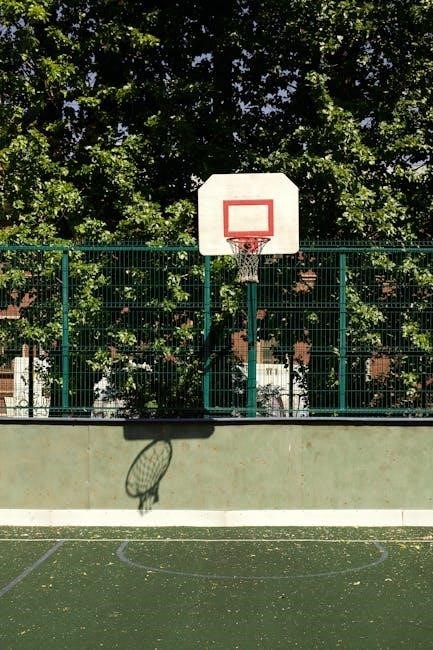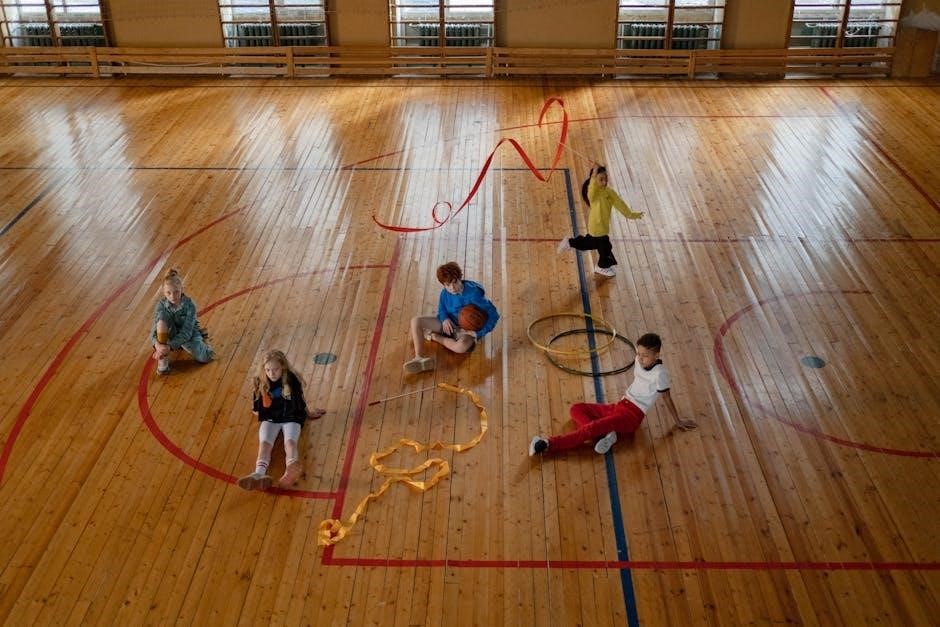
basketball practice plan template pdf
A well-structured basketball practice plan is essential for organizing effective training sessions. It includes drills, strategies, and skill development to improve player performance and teamwork. This template provides a detailed framework.

Importance of a Basketball Practice Plan
A basketball practice plan is crucial for organizing effective training sessions, ensuring productivity, and achieving team goals. It provides a structured approach to skill development, conditioning, and strategy implementation. With a well-designed plan, coaches can maximize practice time, focusing on specific areas such as offense, defense, and teamwork. It also helps in tracking progress, identifying weaknesses, and adjusting strategies accordingly. A practice plan reduces coaching stress by outlining clear objectives and activities, ensuring no time is wasted. Additionally, it fosters accountability among players, encouraging discipline and hard work. For youth teams, a practice plan helps maintain engagement and cater to shorter attention spans. By incorporating warm-ups, drills, and cool-downs, it promotes injury prevention and overall player well-being. Ultimately, a basketball practice plan is a vital tool for coaches to build a competitive and cohesive team, adaptable to various age groups and skill levels. Consistency in practice leads to improved performance in games.

Overview of the Template
The basketball practice plan template offers a comprehensive and customizable framework for coaches to design efficient training sessions. It includes structured sections for warm-ups, skill drills, team strategies, and conditioning exercises. Coaches can input specific drills, coaching points, and time allocations, ensuring practices are well-organized. The template also incorporates spaces for pre- and post-practice routines, such as team meetings and cool-down stretches. It is adaptable to different age groups and skill levels, making it versatile for youth, high school, college, and professional teams. Additionally, the template allows for the inclusion of video resources and tutorial links, providing coaches with supplementary tools. By using this template, coaches can ensure that each practice is purposeful and aligned with the team’s goals, fostering improvement and cohesion. The template’s clarity and flexibility make it an invaluable resource for coaches seeking to elevate their team’s performance. It simplifies the planning process, enabling coaches to focus on execution and player development.

Structure of the Practice Plan
The practice plan is divided into key sections, including warm-up, skill drills, team strategies, conditioning, and cool-down. Each segment is designed to maximize efficiency and player development, ensuring a balanced approach.
Warm-Up and Stretching
The warm-up is crucial to prepare players physically and mentally. It typically includes light cardio, dynamic stretches, and ball-handling drills. This section should last 15-20 minutes, ensuring players increase heart rates and flexibility. For youth teams, fun activities like jogging laps or high knees are effective. For older players, incorporate specific basketball movements like figure-eight dribbling or crossovers. Stretching focuses on major muscle groups—hamstrings, quads, and calves—to prevent injuries. Coaches should demonstrate proper form and emphasize the importance of a dynamic warm-up over static stretches. This routine sets the tone for the rest of practice, promoting focus and readiness.
Skill development drills are designed to improve specific basketball abilities such as shooting, passing, and dribbling. These exercises are tailored to the team’s skill level and goals. For example, youth players might focus on basic ball-handling techniques, while high school athletes could work on advanced moves like crossovers and behind-the-back dribbles. Shooting drills often involve spot-up shots, catch-and-shoot, and off-the-dribble exercises to enhance accuracy and range. Passing drills, such as chest passes and bounce passes, help develop precision and court vision. Coaches should provide clear instructions, demonstrations, and feedback to ensure proper technique. Incorporating game-like scenarios into drills prepares players for real-game situations, fostering better decision-making and teamwork. These structured activities are vital for individual and team growth, ensuring players build a strong foundation and stay competitive. Consistency in practicing these drills leads to measurable improvement over time. Team plays and strategies are essential components of a basketball practice plan, focusing on coordinated actions to outperform opponents. These include offensive plays like pick-and-rolls, fast breaks, and half-court sets, as well as defensive strategies such as man-to-man, zone defense, and press systems. Coaches design these plays to exploit weaknesses in the opposing team while maximizing their own strengths. Drills are often incorporated to simulate game scenarios, helping players learn how to execute plays effectively. For example, offensive drills might focus on ball movement and player spacing, while defensive drills emphasize communication and positioning. Additionally, strategies like out-of-bounds plays and end-of-game situations are practiced to prepare for critical moments. By mastering these team plays and strategies, players develop a deeper understanding of the game and improve their ability to perform under pressure. This section ensures that teams are well-prepared for various game situations. Conditioning exercises are a critical part of any basketball practice plan, designed to improve players’ endurance, strength, and agility. These exercises prepare athletes for the physical demands of the game, ensuring they can perform at their best. Common conditioning drills include sprinting up and down the court, agility ladder exercises, and shuttle runs to enhance speed and quickness. Jump rope and box jumps are also used to boost cardiovascular fitness and explosive power. Core-strengthening exercises like planks and Russian twists help improve balance and stability. Many practice plans incorporate interval training to simulate game-like conditions, alternating between high-intensity bursts and short recovery periods. Proper conditioning not only enhances performance but also reduces the risk of injuries. Coaches often tailor these exercises to the team’s specific needs, ensuring players are physically prepared for the challenges of the season. This focus on conditioning is vital for building a resilient and competitive team. The cool-down and stretching segment of a basketball practice plan is essential for player recovery and injury prevention. After intense drills and conditioning, a proper cool-down helps lower heart rates and relax muscles. Static stretches, such as hamstring, quadriceps, and hip flexor stretches, are commonly included to improve flexibility. Dynamic stretches, like leg swings and arm circles, also promote blood flow and reduce muscle tension. Many practice plans incorporate foam rolling and self-myofascial release techniques to aid in muscle recovery. Coaches often emphasize the importance of hydration during this phase to replenish fluids lost during practice. A well-structured cool-down not only aids in physical recovery but also helps players mentally unwind, preparing them for the next session. Proper stretching and cool-down routines are integral to maintaining player health and performance throughout the season. This practice ensures that athletes can train consistently without unnecessary strain or risk of injury. Downloadable basketball practice plan templates are available online, offering customizable structures for drills, strategies, and skill development. They cater to different age groups and skill levels, ensuring efficient practice organization. Basketball practice plan templates are designed to cater to various age groups, ensuring age-appropriate training. For youth players (ages 5-12), the focus is on fundamental skills like dribbling, shooting, and teamwork, with engaging drills to maintain attention. High school and college templates emphasize advanced techniques, conditioning, and game strategies, preparing players for competitive levels. Professional templates incorporate specialized drills, tactical plays, and mental preparation for peak performance. Each template is structured to match the developmental needs of the players, ensuring efficient skill progression. By tailoring practices to specific age groups, coaches can maximize player growth and team success. These templates are readily available online, offering customizable options to suit unique team requirements. Customizing a basketball practice plan template ensures it aligns with your team’s specific needs and goals. Coaches can tailor drills, strategies, and exercises to address skill gaps and enhance strengths. By adding team name, date, and time, the plan becomes personalized and organized. Specific drills can be included based on the team’s focus, such as offensive plays, defensive techniques, or conditioning exercises. Coaching points and notes can be added to provide clarity and feedback during practice. Many templates offer blank sections for customization, allowing coaches to adapt the plan to their unique requirements. This flexibility ensures that every practice is purposeful and aligned with the team’s objectives. Customization also helps in tracking progress and adjusting strategies as the season evolves. With a well-tailored plan, coaches can maximize efficiency and foster improved performance. Successful basketball practice plan templates are designed to cater to different age groups and skill levels. For instance, youth basketball templates focus on fundamental skills like dribbling, shooting, and teamwork, with engaging drills to keep young players motivated. High school and college templates incorporate more advanced strategies, including offensive and defensive plays, conditioning exercises, and game scenarios. Professional-level templates are highly detailed, often including video analysis, strength training, and mental preparation. Many templates include sample drills, such as warm-up routines, ball-handling exercises, and scrimmages. Examples also show how to structure practices chronologically, ensuring a balance between skill development and physical conditioning. These templates serve as blueprints for coaches to create effective, organized, and impactful practices tailored to their team’s needs. By following these examples, coaches can ensure their practices are structured, focused, and productive. Additional resources for basketball practice plans include downloadable PDF templates, video guides, and coaching tips from websites like blueprintbasketball.com and basketballforcoaches.com. These templates provide drills, strategies, and sample plans for various skill levels and age groups, helping coaches organize effective and engaging practices. Coaches can find basketball practice plan templates on various websites such as blueprintbasketball.com and basketballforcoaches.com. These platforms offer free downloadable PDF templates designed for different skill levels and age groups. Additionally, resources like the YMCA and FIBA provide youth-focused templates and comprehensive guides. Websites often include sample plans, drills, and strategies to help coaches create structured practices. Some sites also offer customizable templates that can be tailored to specific team needs. For those looking for detailed drills and video guides, Start Coaching courses are available. These resources ensure coaches have access to tools that cater to their team’s unique requirements, whether it’s for youth, college, or professional levels. Video guides and tutorials are essential resources for coaches to enhance their practice planning skills. Websites like blueprintbasketball.com and basketballforcoaches.com offer video tutorials that demonstrate drills, strategies, and practice organization. These videos provide visual instruction on how to execute specific skills, such as ball handling, shooting, and defensive techniques. Additionally, platforms like FIBA and YMCA provide instructional videos tailored for youth basketball, focusing on age-appropriate drills and skill development. Coaches can also find video guides on YouTube and other sports education channels, covering topics like practice structure, player motivation, and game-day preparation. These resources help coaches implement their practice plans effectively and ensure players improve their skills. By combining video tutorials with downloadable templates, coaches can create comprehensive and engaging training sessions for their teams. Effective coaching begins with a well-structured plan, and using a basketball practice plan template can significantly enhance your approach. Start by setting clear goals for each session, ensuring they align with your team’s overall objectives. Incorporate a mix of skill development, conditioning, and team strategy drills to keep practices dynamic. For younger players, focus on fundamental skills like ball handling and shooting, while older teams can delve into advanced strategies; Utilize time management techniques to maximize efficiency during practice, balancing instruction with active participation. Communication is key—provide constructive feedback and encourage player input. Adapt drills to suit your team’s needs and keep the atmosphere positive to foster growth and teamwork. Access resources like video guides and templates from sites such as basketballforcoaches.com and blueprintbasketball.com for additional support. Remember, flexibility and creativity are essential for creating impactful practices. Discover a variety of sample basketball practice plans tailored for different age groups and skill levels. From youth to professional teams, these plans offer structured drills and strategies to enhance performance. A youth basketball practice plan focuses on developing fundamental skills through engaging and age-appropriate activities. For younger players (ages 5-7), practices emphasize fun and basic movement skills, while older youth (ages 9-10) begin to learn team concepts. The plan typically includes a warm-up with dynamic stretches and ball-handling drills, followed by skill stations for shooting, passing, and defense. Scrimmages and small-sided games help apply these skills in real-game scenarios. The template also incorporates breaks for water and team discussions to build camaraderie. Coaches can customize the plan to suit the group’s energy levels and learning pace, ensuring a positive experience for all players. Example drills include dribbling relays, shooting contests, and defensive stance exercises. The goal is to create a balanced practice that fosters both skill development and a love for the game. High school and college basketball practice plans are designed to enhance advanced skills and prepare players for competitive games. These plans typically include detailed drills for shooting, ball handling, and defensive techniques, along with team strategy sessions. Conditioning exercises are intensified to improve endurance and strength, ensuring players can perform at peak levels throughout the season. The template often includes sections for reviewing game footage, analyzing opponents, and developing plays tailored to the team’s strengths. Coaches can customize the plan to focus on specific areas, such as offensive sets or defensive schemes. Additionally, scrimmages and situational drills simulate game-day scenarios, helping players make quick decisions under pressure. The goal is to create a cohesive unit that excels in both individual and team performance. These plans are adaptable to suit the demands of higher-level competition. Professional basketball practice plans are highly detailed and tailored to meet the demands of elite-level competition. These plans focus on refining advanced skills, optimizing teamwork, and preparing players for high-stakes games. They often include specialized drills for strength, speed, and agility, as well as strategic sessions for both offense and defense. Video analysis and opponent scouting are integral components, allowing teams to exploit weaknesses and perfect their execution. Conditioning is intensified to ensure players can maintain peak performance throughout the season. Additionally, these plans emphasize mental preparation, including leadership development and game-day mindset training. Coaches at this level work closely with players to address individual needs and refine specific roles within the team. The goal is to create a cohesive, adaptable unit capable of excelling in the most competitive environments. These plans are constantly evolving to stay ahead of the game. A well-structured basketball practice plan is vital for improving performance and fostering teamwork. Use templates to organize drills, strategies, and conditioning, ensuring your team reaches its full potential. A basketball practice plan template is a vital tool for coaches to organize and structure training sessions effectively. It ensures that all aspects of player development, from drills and strategies to conditioning and teamwork, are addressed systematically. The template typically includes sections for warm-ups, skill development, team plays, and conditioning exercises, providing a clear roadmap for coaches. With customizable options, it caters to different age groups and skill levels, making it adaptable for youth, high school, college, and professional teams. Resources like free PDF downloads and video guides further enhance the planning process, offering practical tips and drills. By using a well-structured practice plan, coaches can maximize practice time, improve player performance, and foster a cohesive team environment. This approach not only enhances skills but also prepares players mentally and physically for game-day challenges. Using a basketball practice plan template is a proactive step toward elevating your team’s performance and ensuring productive training sessions. By leveraging these resources, coaches can save time, reduce stress, and focus on what truly matters—developing their players’ skills and fostering teamwork. The availability of customizable templates, video guides, and expert tips makes it easier than ever to create a structured and effective practice schedule. Encourage your players to embrace the process, as consistent execution of the plan will lead to measurable improvement. Whether you’re coaching youth, high school, or professional players, a well-designed practice plan is the foundation for success. Don’t hesitate to download and start implementing the plan today—your team’s growth and achievements will reflect the effort you put into organizing their training.Skill Development Drills
Team Plays and Strategies

Conditioning Exercises
Cool-Down and Stretching

Basketball Practice Plan Templates
Templates for Different Age Groups
Customizing the Template for Your Team
Examples of Successful Templates

Additional Resources
Where to Find Templates
Video Guides and Tutorials
Coaching Tips and Tricks

Sample Practice Plans
Youth Basketball Practice Plan
High School and College Practice Plans
Professional Level Practice Plans


Summarizing the Key Points
Encouragement to Use the Plan
Related Posts

pdo to pdf
Need to generate PDFs from PHP? 2 Bears & Counting shows you how to effortlessly convert PDO data into beautiful, professional PDFs. Get the code & learn now!

12 hours sleep by 12 weeks pdf
Struggling with baby sleep? Discover how to get your little one sleeping 12 hours a night by 12 weeks with this popular guide! Download the PDF now & reclaim your nights. **12 hours sleep** awaits!

totem pole animals and their meanings pdf
Dive into the fascinating world of totem poles! Discover the powerful symbolism of animals like bears, eagles & wolves. Download our PDF guide & connect with nature’s spirit. ✨